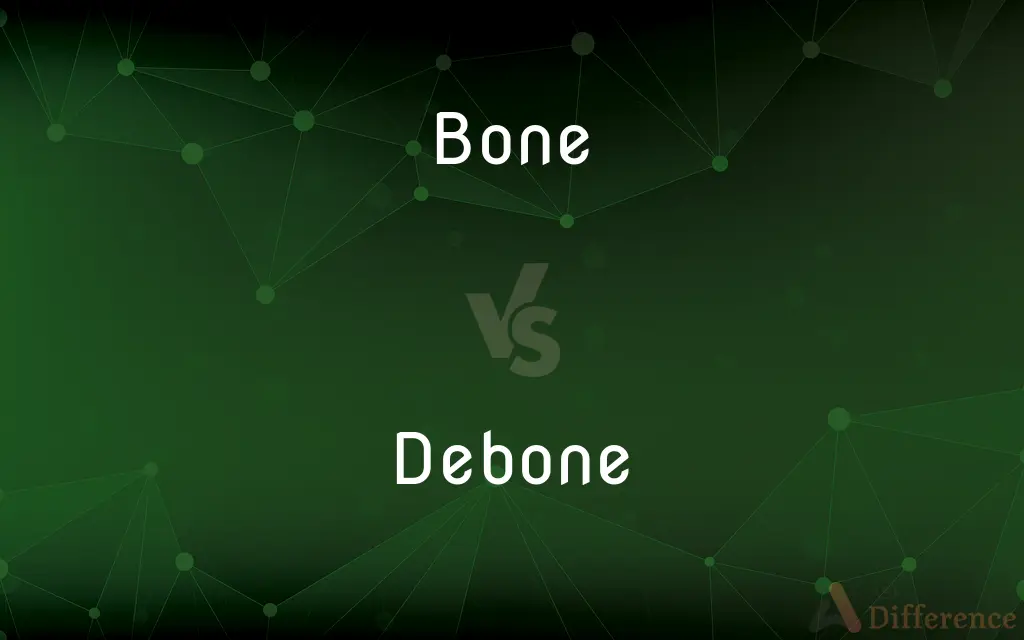Bone vs. Debone — What's the Difference?
Edited by Tayyaba Rehman — By Urooj Arif — Updated on April 20, 2024
Bone refers to the hard, structural components within vertebrates, crucial for support and protection; debone, however, is the process of removing these bones from meat or fish.

Difference Between Bone and Debone
Table of Contents
ADVERTISEMENT
Key Differences
Bone is a rigid organ that constitutes part of the vertebral skeleton, mainly composed of collagen and calcium phosphate, which provides structural support and protection for the body. Whereas debone is a culinary term that involves removing bones from meat or fish to ease consumption and preparation.
Bone also plays a crucial role in producing blood cells and storing minerals, vital for overall health. On the other hand, the act of deboning can influence the cooking method and texture of the meat, as boneless meat often cooks faster and can be less flavorful than bone-in cuts.
Bone has various types, including long bones in the arms and legs, flat bones like the skull, and irregular bones such as those in the vertebrae. While debone generally refers to the removal of these types of bones from cuts of meat or fish, depending on the culinary needs.
Bone is essential for bodily movements as it is attached to muscles via tendons, facilitating leverage and movement. Whereas when meat is deboned, it may require different cooking techniques, such as tying or rolling, to maintain its shape during cooking.
Bone serves as a storehouse for essential nutrients, including calcium and phosphate, which can be released into the body as needed. On the other hand, deboning meat often means these nutrients, especially those derived from marrow and surrounding tissues, are minimized in the final culinary product.
ADVERTISEMENT
Comparison Chart
Definition
Hard, rigid organ within vertebrates.
Process of removing bones from meat or fish.
Function
Provides structural support and protection.
Facilitates easier consumption and preparation of meat.
Types
Long, flat, and irregular bones.
Not applicable.
Relationship to Meat
Integral part of vertebrates.
Process applied to meat after harvesting.
Cooking Impact
Influences flavor and cooking time.
Often results in faster cooking times.
Compare with Definitions
Bone
Plays a role in movement by attaching to muscles.
Bones move when muscles contract and pull on them.
Debone
To remove the bones from meat or fish.
Chefs debone chicken for certain recipes to ease eating.
Bone
Essential for hematopoiesis, the production of blood cells.
Red blood cells are produced in the bone marrow of long bones.
Debone
Enhances the presentation and uniformity of cooking.
Deboned fish fillets cook more evenly than whole fish.
Bone
Acts as a mineral reserve, particularly for calcium and phosphorus.
Bones release calcium into the bloodstream when needed.
Debone
Requires skill and proper tools like fillet knives.
Proper deboning ensures minimal waste and preserves meat quality.
Bone
A structural component of the vertebrate skeleton.
Human bones include the femur and the ribcage.
Debone
Can influence the texture and flavor of the meat.
Deboned meat can be less juicy than bone-in cuts.
Bone
Involved in the protection of internal organs.
The skull bone protects the brain from injury.
Debone
Often necessary for specific dishes like stuffed poultry.
Deboning a turkey before stuffing it is common practice.
Bone
Former name for Annaba
Debone
To remove the bones from
Debone a chicken breast.
Bone
Remove the bones from (meat or fish) before cooking, serving, or selling
Ask your butcher to bone the turkey for you
Debone
(ambitransitive) To remove the bones from.
I am deboning a fish.
Bone
Study (a subject) intensively, typically in preparation for something
She boned up on languages she had learned long ago
Debone
Remove the bones from;
Bone the turkey before roasting it
Bone
The dense, semirigid, porous, calcified connective tissue forming the major portion of the skeleton of most vertebrates. It consists of a dense organic matrix and an inorganic, mineral component.
Bone
Any of numerous anatomically distinct structures making up the skeleton of a vertebrate animal. There are more than 200 different bones in the human body.
Bone
A piece of bone.
Bone
The skeleton.
Bone
The body
These old bones don't do much dancing anymore.
Bone
Mortal remains
His bones are buried up on the hill.
Bone
An animal structure or material, such as ivory, resembling bone.
Bone
A piece of whalebone or similar material used as a corset stay.
Bone
Bones(Informal) Dice.
Bone
Bones The fundamental plan or design, as of the plot of a book.
Bone
Bones Flat clappers made of bone or wood originally used by the end man in a minstrel show.
Bone
Bones (used with a sing. verb) The end man in a minstrel show.
Bone
Vulgar Slang The penis.
Bone
To remove the bones from
Bone a fish.
Bone
To stiffen (a piece of clothing) with stays, as of whalebone.
Bone
(uncountable) A composite material consisting largely of calcium phosphate and collagen and making up the skeleton of most vertebrates.
Bone
(countable) Any of the components of an endoskeleton, made of bone.
Bone
A bone of a fish; a fishbone.
Bone
A bonefish.
Bone
One of the rigid parts of a corset that forms its frame, the boning, originally made of whalebone.
Bone
One of the fragments of bone held between the fingers of the hand and rattled together to keep time to music.
Bone
Anything made of bone, such as a bobbin for weaving bone lace.
Bone
(figurative) The framework of anything.
Bone
An off-white colour, like the colour of bone.
Bone
A dollar.
Bone
The wishbone formation.
Bone
(slang) An erect penis; a boner.
Bone
A domino or dice.
Bone
(slang) A cannabis cigarette; a joint.
Bone
(figurative) A reward.
Bone
(slang) trombone
Bone
Of an off-white colour, like the colour of bone.
Bone
To prepare (meat, etc) by removing the bone or bones from.
Bone
To fertilize with bone.
Bone
To put whalebone into.
Bone
(civil engineering) To make level, using a particular procedure; to survey a level line.
Boning rod
Bone
To perform "bone pointing", a ritual that is intended to bring illness or even death to the victim.
Bone
(usually with "up") To study.
Bone up
Bone
To polish boots to a shiny finish.
Bone
To nag, especially for an unpaid debt.
Bone
To apprehend, steal.
Bone
To sight along an object or set of objects to check whether they are level or in line.
Bone
One of the pieces or parts of an animal skeleton; as, a rib or a thigh bone; a bone of the arm or leg; also, any fragment of bony substance. (pl.) The frame or skeleton of the body.
Bone
Anything made of bone, as a bobbin for weaving bone lace.
Bone
Two or four pieces of bone held between the fingers and struck together to make a kind of music.
Bone
Dice.
Bone
Whalebone; hence, a piece of whalebone or of steel for a corset.
Bone
Fig.: The framework of anything.
Bone
To withdraw bones from the flesh of, as in cookery.
Bone
To put whalebone into; as, to bone stays.
Bone
To fertilize with bone.
Bone
To steal; to take possession of.
Bone
To sight along an object or set of objects, to see if it or they be level or in line, as in carpentry, masonry, and surveying.
Joiners, etc., bone their work with two straight edges. W.
Bone
Rigid connective tissue that makes up the skeleton of vertebrates
Bone
The porous calcified substance from which bones are made
Bone
A shade of white the color of bleached bones
Bone
Study intensively, as before an exam;
I had to bone up on my Latin verbs before the final exam
Bone
Remove the bones from;
Bone the turkey before roasting it
Bone
Consisting of or made up of bone;
A bony substance
The bony framework of the body
Common Curiosities
Why is bone important in the body?
Bone is crucial for structural support, protection of internal organs, and storage of minerals.
What is bone made of?
Bone is primarily made up of collagen, a type of protein, and calcium phosphate, a mineral.
What does debone mean in cooking?
Debone refers to the process of removing bones from meat or fish for easier preparation and consumption.
Are all bones in the body the same?
No, bones in the body vary in shape and size, including long, flat, and irregular types.
Does deboning require special tools?
Yes, deboning requires specific tools like sharp knives and often a skilled technique.
What is the difference between bone-in and boneless cuts?
Bone-in cuts include the bone, which can enhance flavor and moisture during cooking, while boneless cuts are without bone.
Can all meat be deboned?
Most meat can be deboned, although the ease and necessity vary by type and cut of meat.
How does deboning affect the cooking process?
Deboning typically allows for faster cooking times and can alter the texture of the meat.
What nutritional benefits do bones provide?
Bones provide minerals such as calcium and phosphorus and contain bone marrow, which is nutritious.
How does deboning affect the flavor of meat?
Deboning can reduce the flavor intensity as bones contribute to the taste during cooking.
Is deboning necessary for all meat dishes?
No, deboning is not necessary for all dishes; some recipes benefit from cooking meat on the bone.
How do bones help in movement?
Bones provide a framework for muscles and tendons to attach to, facilitating movement.
What are the types of bones used in culinary dishes?
In culinary uses, bones such as ribs, leg bones, and backbones are common.
Are there health risks associated with deboning meat?
Improper deboning can lead to bone fragments in meat, which pose choking or injury risks.
Share Your Discovery

Previous Comparison
Gymnastics vs. Cheerleading
Next Comparison
Application vs. DriverAuthor Spotlight
Written by
Urooj ArifUrooj is a skilled content writer at Ask Difference, known for her exceptional ability to simplify complex topics into engaging and informative content. With a passion for research and a flair for clear, concise writing, she consistently delivers articles that resonate with our diverse audience.
Edited by
Tayyaba RehmanTayyaba Rehman is a distinguished writer, currently serving as a primary contributor to askdifference.com. As a researcher in semantics and etymology, Tayyaba's passion for the complexity of languages and their distinctions has found a perfect home on the platform. Tayyaba delves into the intricacies of language, distinguishing between commonly confused words and phrases, thereby providing clarity for readers worldwide.














































